Hyperspectral Infrared Observations of Arctic Snow, Sea Ice, and Non-Frozen Ocean from the RV Polarstern during the MOSAiC Expedition October 2019 to September 2020
Abstract
:1. Introduction
2. Materials and Methods
3. Results
3.1. Near-Surface Air Temperature
3.2. Surface Skin Temperature and Infrared Emissivity
3.2.1. Surface Skin Temperature
3.2.2. Surface Infrared Emissivity
3.3. Satellite Sounder Profile Validation
3.3.1. Temperature and Water Vapor Profile Comparison
3.3.2. Surface Infrared Temperature and Emissivity Comparison
4. Discussion
5. Conclusions
Author Contributions
Funding
Data Availability Statement
Acknowledgments
Conflicts of Interest
Appendix A
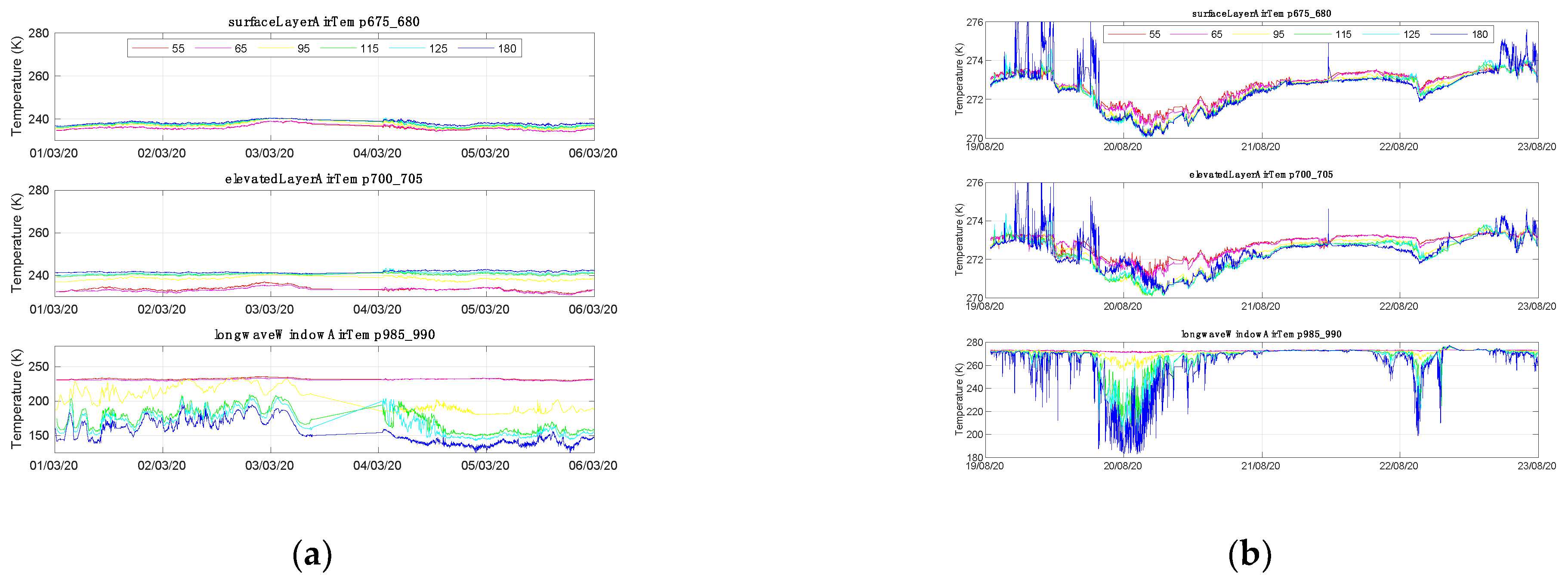

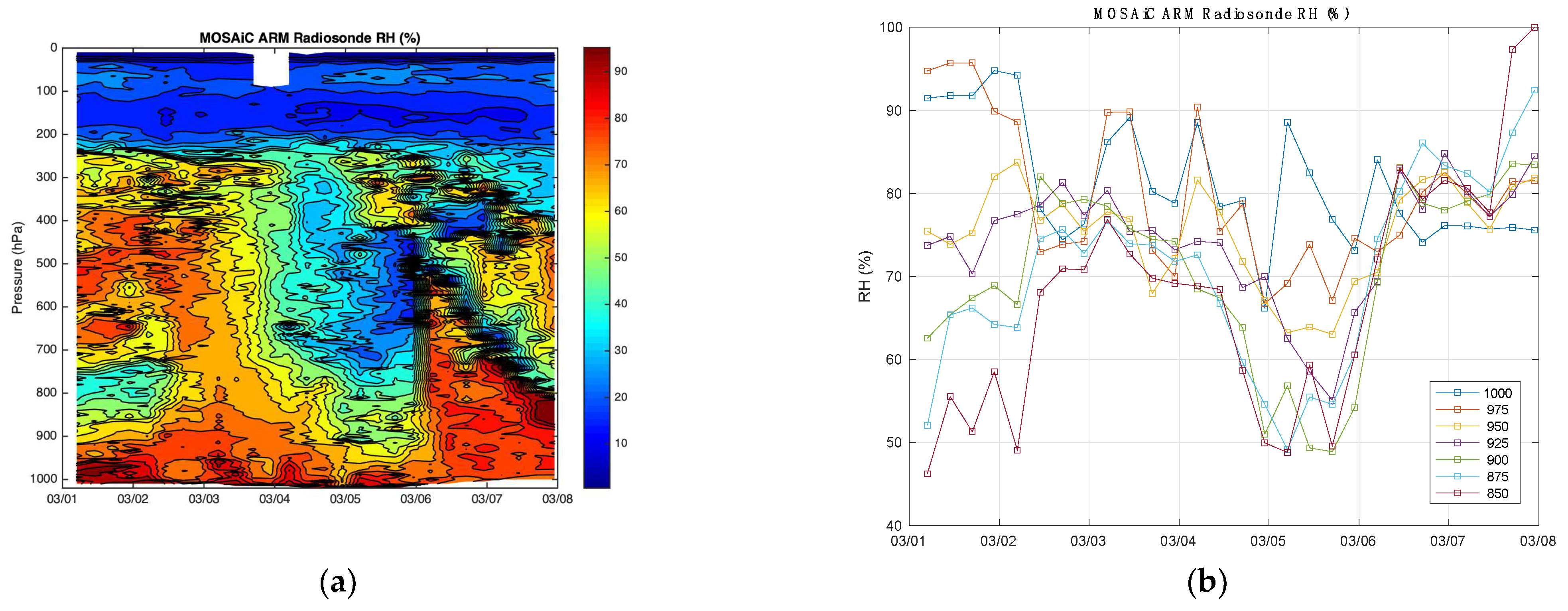

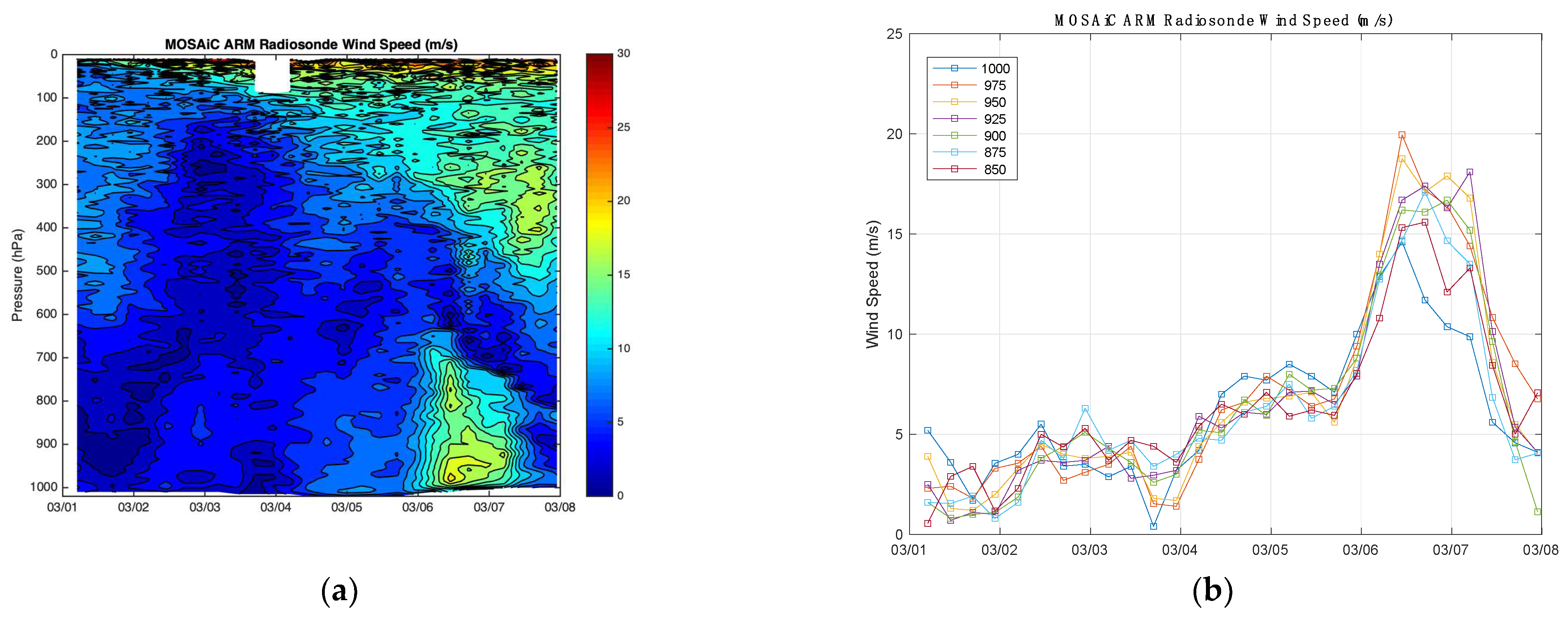
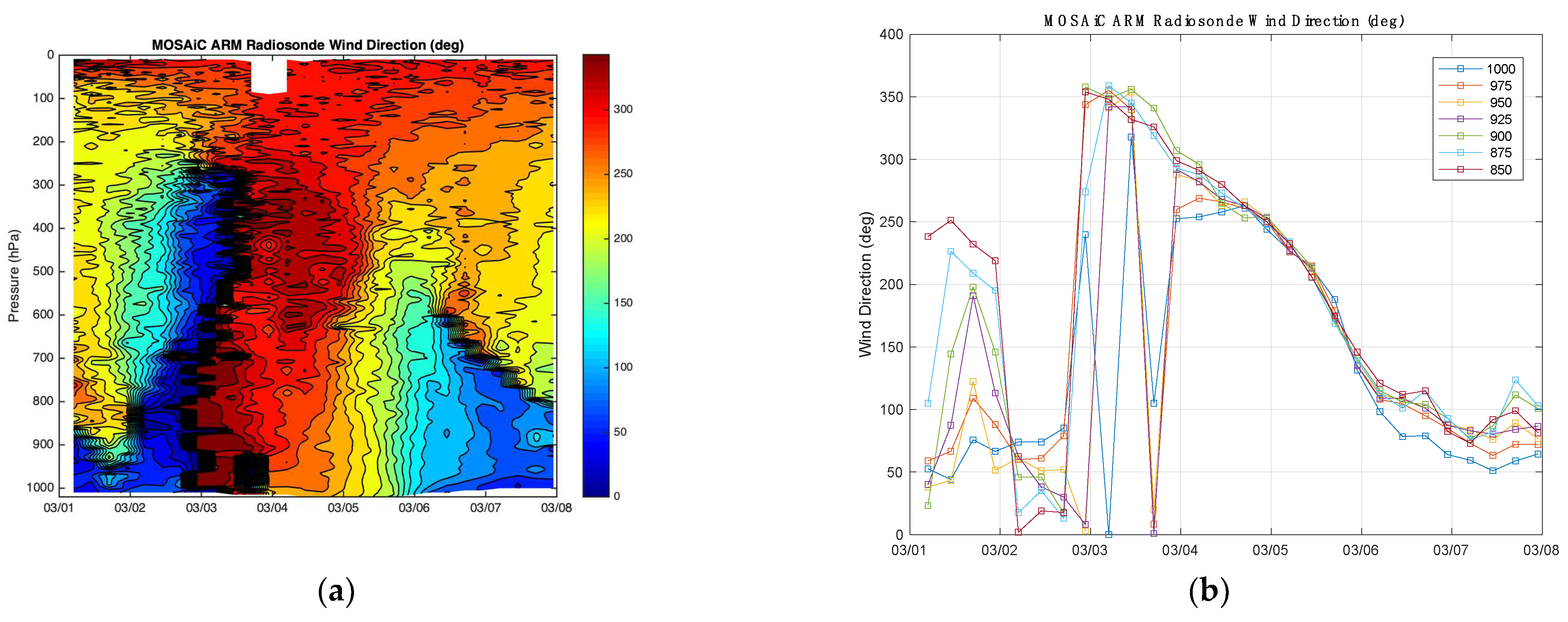


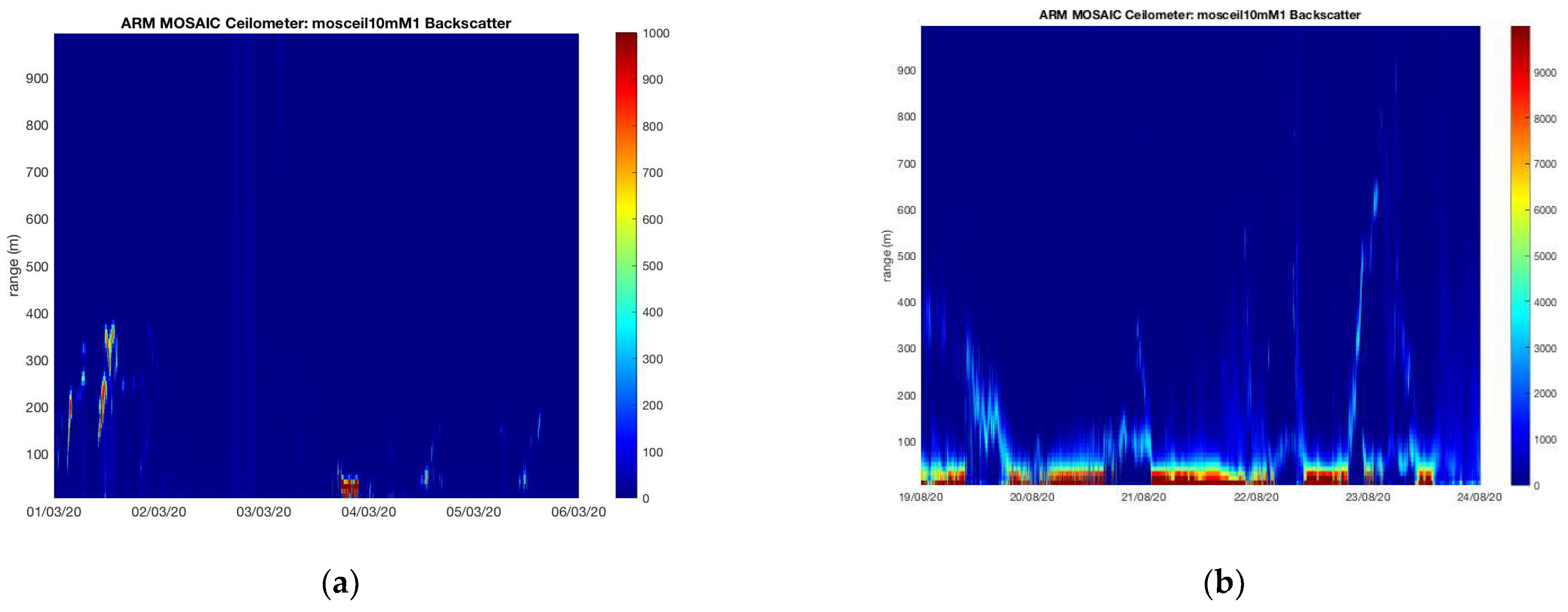
References
- Wood, K.R.; Bond, N.A.; Danielson, S.L.; Overland, J.E.; Salo, S.A.; Stabeno, P.J.; Whitefield, J. A decade of environmental change in the Pacific Arctic region. Prog. Oceanogr. 2015, 136, 12–31. [Google Scholar] [CrossRef]
- Box, J.E.; Colgan, W.T.; Christensen, T.R.; Schmidt, N.M.; Lund, M.; Parmentier, F.J.W.; Brown, R.; Bhatt, U.S.; Euskirchen, E.S.; Romanovsky, V.E.; et al. Key indicators of Arctic climate change: 1971–2017. Environ. Res. Lett. 2019, 14, 045010. [Google Scholar] [CrossRef]
- Shupe, M.D.; Rex, M.; Dethloff, K.; Damm, E.; Fong, A.A.; Gradinger, R.; Heuze, C.; Loose, B.; Makarov, A.; Maslowski, W.; et al. The MOSAiC expedition: A year drifting with the Arctic sea ice. In Arctic Report Card 2020; Thoman, R.L., Richter-Menge, J., Druckenmiller, M.L., Eds.; National Oceanic and Atmospheric Administration: Washington, DC, USA, 2020; pp. 1–8. [Google Scholar] [CrossRef]
- Shupe, M.D.; Rex, M. A year in the changing Arctic sea ice. Oceanography 2022, 35, 224–225. [Google Scholar] [CrossRef]
- Shupe, M.D.; Rex, M.; Blomquist, B.; Persson, P.O.G.; Schmale, J.; Uttal, T.; Althausen, D.; Angot, H.; Archer, S.; Bariteau, L.; et al. Overview of the MOSAiC expedition: Atmosphere. Elementa 2022, 10, 00060. [Google Scholar] [CrossRef]
- Nicolaus, M.; Perovich, D.K.; Spreen, G.; Granskog, M.A.; Albedyll, L.V.; Anhaus, P.; Angelopoulos, M.; Arndt, S.; Belter, H.J.; Bessonov, V.; et al. Overview of the MOSAiC expedition: Snow and sea ice. Elementa 2022, 10, 000046. [Google Scholar] [CrossRef]
- Nixdorf, U.; Dethloff, K.; Rex, M.; Shupe, M.; Sommerfeld, A.; Perovich, D.; Nicolas, M.; Heuze, C.; Rabe, B.; Loose, B.; et al. MOSAiC extended acknowledgement. Zenodo 2021. [Google Scholar] [CrossRef]
- Rabe, B.; Heuzé, C.; Regnery, J.; Aksenov, Y.; Allerholt, J.; Athanase, M.; Bai, Y.; Basque, C.; Bauch, D.; Baumann, T.M.; et al. Overview of the MOSAiC expedition: Physical oceanography. Elementa 2022, 10, 00062. [Google Scholar] [CrossRef]
- Krumpen, T.; von Albedyll, L.; Goessling, H.F.; Hendricks, S.; Juhls, B.; Spreen, G.; Willmes, S.; Belter, H.J.; Dethloff, K.; Haas, C.; et al. MOSAiC drift expedition from October 2019 to July 2020: Sea ice conditions from space and comparison with previous years. Cryosphere 2021, 15, 3897–3920. [Google Scholar] [CrossRef]
- Stroeve, J.; Nandan, V.; Willatt, R.; Dadic, R.; Rostosky, P.; Gallagher, M.; Mallett, R.; Barrett, A.; Hendricks, S.; Tonboe, R.; et al. Rain on snow (ROS) understudied in sea ice remote sensing: A multi-sensor analysis of ROS during MOSAiC (Multidisciplinary drifting Observatory for the Study of Arctic Climate). Cryosphere 2022, 16, 4223–4250. [Google Scholar] [CrossRef]
- Angot, H.; Blomquist, B.; Howard, D.; Archer, S.; Bariteau, L.; Beck, I.; Boyer, M.; Crotwell, M.; Helmig, D.; Hueber, J.; et al. Year-round trace gas measurements in the central Arctic during the MOSAiC expedition. Sci. Data 2022, 9, 723. [Google Scholar] [CrossRef]
- Boyer, M.; Aliaga, D.; Pernov, J.B.; Angot, H.; Quéléver, L.L.; Dada, L.; Heutte, B.; Dall’Osto, M.; Beddows, D.; Brasseur, Z.; et al. A full year of aerosol size distribution data from the central Arctic under an extreme positive Arctic Oscillation: Insights from the Multidisciplinary drifting Observatory for the Study of Arctic Climate (MOSAiC) expedition. Atmos. Chem. Phys. 2023, 23, 389–415. [Google Scholar] [CrossRef]
- DOE ARM Mobile Facility. AMF2 Description Publication. Available online: https://www.arm.gov/news/features/post/71644 (accessed on 1 June 2022).
- Gero, J.; Garcia, R.; Hackel, D.; Ermold, B.; Gaustad, K. Atmospheric Emitted Radiance Interferometer (AERICH1). Atmospheric Radiation Measurement (ARM) User Facility. 2019. Available online: https://adc.arm.gov/discovery/#v/results/s/fdsc::aerich1 (accessed on 30 April 2023). [CrossRef]
- Minnett, P.J.; Knuteson, R.O.; Best, F.A.; Osborne, B.J.; Hanafin, J.A.; Brown, O.B. The Marine-Atmospheric Emitted Radiance Interferometer: A high-accuracy, seagoing infrared spectroradiometer. J. Atmos. Ocean. Technol. 2001, 18, 994–1013. [Google Scholar] [CrossRef]
- Knuteson, R.O.; Best, F.A.; Ciganovich, N.C.; Dedecker, R.G.; Dirkx, T.P.; Ellington, S.; Feltz, W.F.; Garcia, R.K.; Herbsleb, R.A.; Howell, H.B.; et al. Atmospheric Emitted Radiance Interferometer (AERI): Part I: Instrument design. J. Atmos. Ocean. Technol. 2004, 21, 1763–1776. [Google Scholar] [CrossRef]
- Knuteson, R.O.; Best, F.A.; Ciganovich, N.C.; Dedecker, R.G.; Dirkx, T.P.; Ellington, S.; Feltz, W.F.; Garcia, R.K.; Herbsleb, R.A.; Howell, H.B.; et al. Atmospheric Emitted Radiance Interferometer (AERI): Part II: Instrument performance. J. Atmos. Ocean. Technol. 2004, 21, 1777–1789. [Google Scholar] [CrossRef]
- Smith, W.L.; Feltz, W.F.; Knuteson, R.O.; Revercomb, H.E.; Woolf, H.M.; Howell, H.B. The retrieval of planetary boundary layer structure using ground-based infrared spectral radiance measurements. J. Atmos. Ocean. Technol. 1999, 16, 323–333. [Google Scholar] [CrossRef]
- Feltz, W.F.; Smith, W.L.; Knuteson, R.O.; Revercomb, H.E.; Woolf, H.M.; Howell, H.B. Meteorological applications of temperature and water vapor retrievals from the ground-based Atmospheric Emitted Radiance Interferometer (AERI). J. Appl. Meteorol. 1998, 37, 857–875. [Google Scholar] [CrossRef]
- Turner, D.D.; Löhnert, U. Information content and uncertainties in thermodynamic profiles and liquid cloud properties retrieved from the ground-based Atmospheric Emitted Radiance Interferometer (AERI). J. Appl. Meteorol. Climatol. 2014, 53, 752–771. [Google Scholar] [CrossRef]
- Smith, W.L.; Knuteson, R.O.; Revercomb, H.E.; Feltz, W.; Howell, H.B.; Menzel, W.P.; Nalli, N.; Brown, O.; Brown, J.; Minnett, P.; et al. Observations of the infrared radiative properties of the ocean—Implications for the measurement of sea surface temperature via satellite remote sensing. Bull. Am. Meteorol. Soc. 1996, 77, 41–51. [Google Scholar] [CrossRef]
- Tobin, D.C.; Best, F.A.; Brown, P.D.; Clough, S.A.; Dedecker, R.G.; Ellingson, R.G.; Garcia, R.K.; Howell, H.B.; Knuteson, R.O.; Mlawer, E.J.; et al. Downwelling spectral radiance observations at the SHEBA ice station: Water vapor continuum measurements from 17 to 26 µm. J. Geophys. Res. 1999, 104, 2081–2092. [Google Scholar] [CrossRef]
- Loveless, D.M.; Wagner, T.J.; Knuteson, R.O.; Turner, D.D.; Ackerman, S.A. Information Content of a Synergy of Ground-Based and Space-Based Infrared Sounders. Part I: Clear-Sky Environments. J. Atmos. Ocean. Technol. 2022, 39, 771–787. [Google Scholar] [CrossRef]
- Nalli, N.R.; Foltz, G.R.; Gero, J.; Gibson, L.; Knuteson, R.O.; Lumpkin, R.; Minnett, P.J.; Morris, V.R.; Ondrusek, M.; Perez, R.C.; et al. Ship-based cal/val campaigns. In Field Measurements for Passive Environmental Remote Sensing; Elsevier: Amsterdam, The Netherlands, 2023; pp. 195–217. [Google Scholar]
- Nalli, N.R.; Gambacorta, A.; Liu, Q.; Barnet, C.D.; Tan, C.; Iturbide-Sanchez, F.; Reale, T.; Sun, B.; Wilson, M.; Borg, L.; et al. Validation of atmospheric profile retrievals from the SNPP NOAA-unique combined atmospheric processing system. Part 1: Temperature and moisture. IEEE Trans. Geosci. Remote Sens. 2017, 56, 180–190. [Google Scholar] [CrossRef]
- Padmanabhan, S.; Drouin, B.; L’Ecuyer, T.; White, M.; Lim, B.; Kenyon, M.; Mariani, G.; McGuire, J.; Raouf, N.; De Santos, O.; et al. The Polar Radiant Energy in the Far Infrared Experiment (PREFIRE). In Proceedings of the IGARSS 2019—2019 IEEE International Geoscience and Remote Sensing Symposium, Yokohama, Japan, 28 July–2 August 2019; pp. 8834–8836. [Google Scholar]
- Agócs, T.; Vanin, F.; Laberinti, P.; Oetjen, H.; Serlenga, D.; Sole, M.P.; Salenc, C.; Lamarre, D.; Kaspers, M.; Rodrigues, G.; et al. Far-Infrared Outgoing Radiation Understanding and Monitoring (FORUM)–System Overview and Key Technology Developments of ESA’s 9 th Earth Explorer. In Proceedings of the IGARSS 2022–2022 IEEE International Geoscience and Remote Sensing Symposium, Kuala Lumpur, Malaysia, 17–22 July 2022; pp. 7186–7189. [Google Scholar]
- Gero, P.J.; Knuteson, R.O.; Hackel, D.J.; Best, F.A.; Garcia, R.K.; Phillips, C.M.; Revercomb, H.E.; Smith, W.L.; Verret, E.; Lantagne, S.M.; et al. A new marine atmospheric emitted radiance interferometer for shipboard atmospheric and oceanic observations. In Proceedings of the Fourier Transform Spectroscopy, Lake Arrowhead, CA, USA, 1–4 March 2015; Optical Society of America: Washington, DC, USA, 2015; p. JM1A-2. [Google Scholar]
- Atmospheric Radiation Measurement (ARM) User Facility. Atmospheric Emitted Radiance Interferometer (AERISUMMARY). 2019-10-11 to 2020-09-19. In ARM Mobile Facility (MOS) MOSAiC (Drifting Obs—Study of Arctic Climate), AMF2 (M1); Gero, J., Garcia, R., Hackel, D., Ermold, B., Gaustad, K., Eds.; ARM Data Center: 2019. Available online: https://adc.arm.gov/discovery/#/results/instrument_code::aerisummary (accessed on 6 January 2023). [CrossRef]
- Knuteson, R.O.; Best, F.A.; DeSlover, D.H.; Osborne, B.J.; Revercomb, H.E.; Smith, W.L., Sr. Infrared land surface remote sensing using high spectral resolution aircraft observations. Adv. Space Res. 2004, 33, 1114–1119. [Google Scholar] [CrossRef]
- Thielke, L.; Huntemann, M.; Hendricks, S.; Jutila, A.; Ricker, R.; Spreen, G. Sea ice surface temperatures from helicopter-borne thermal infrared imaging during the MOSAiC expedition. Sci. Data 2022, 9, 364. [Google Scholar] [CrossRef] [PubMed]
- Atmospheric Radiation Measurement (ARM) User Facility. Meteorological Measurements associated with the Aerosol Observing System (AOSMET), 2020-05-14 to 2020-10-01. In ARM Mobile Facility (MOS) MOSAiC (Drifting Obs—Study of Arctic Climate), AMF2 (M1); Kyrouac, J., Springston, S., Tuftedal, M., Eds.; ARM Data Center: 2019. Available online: https://adc.arm.gov/discovery/#/results/instrument_code::aosmet (accessed on 6 January 2023). [CrossRef]
- Atmospheric Radiation Measurement (ARM) User Facility. Infrared Thermometer (GNDIRT), 2020-04-18 to 2020-09-18. In ARM Mobile Facility (MOS) Collocated Instruments on Ice (S3); Shi, Y., Ed.; ARM Data Center: 2019. Available online: https://adc.arm.gov/discovery/#/results/instrument_code::gndirt/dataLevel::b1 (accessed on 6 January 2023). [CrossRef]
- Atmospheric Radiation Measurement (ARM) User Facility. Balloon-Borne Sounding System (SONDEWNPN), 2019-10-11 to 2020-10-01. In ARM Mobile Facility (MOS) MOSAiC (Drifting Obs—Study of Arctic Climate), AMF2 (M1). Keeler, E., Burk, K., Eds.; ARM Data Center: 2019. Available online: https://adc.arm.gov/discovery/#/results/instrument_code::sondewnpn/dataLevel::b1 (accessed on 6 January 2023). [CrossRef]
- Atmospheric Radiation Measurement (ARM) User Facility. Ceilometer (CEIL). 2019-10-11 to 2020-10-01. In ARM Mobile Facility (MOS) MOSAiC (Drifting Obs—Study of Arctic Climate), AMF2 (M1); Morris, V., Zhang, D., Ermold, B., Eds.; ARM Data Center: 2019. Available online: https://adc.arm.gov/discovery/#/results/instrument_code::ceil (accessed on 6 January 2023). [CrossRef]
- Minnett, P.J.; Knuteson, R.O.; Gero, J. Surface-based thermal infrared spectrometers. In Field Measurements for Passive Environmental Remote Sensing; Elsevier: Amsterdam, The Netherlands, 2023; pp. 101–120. [Google Scholar]
- Luo, B.; Minnett, P.J. Evaluation of the ERA5 sea surface skin temperature with remotely-sensed shipborne marine-atmospheric emitted radiance interferometer data. Remote Sens. 2020, 12, 1873. [Google Scholar] [CrossRef]

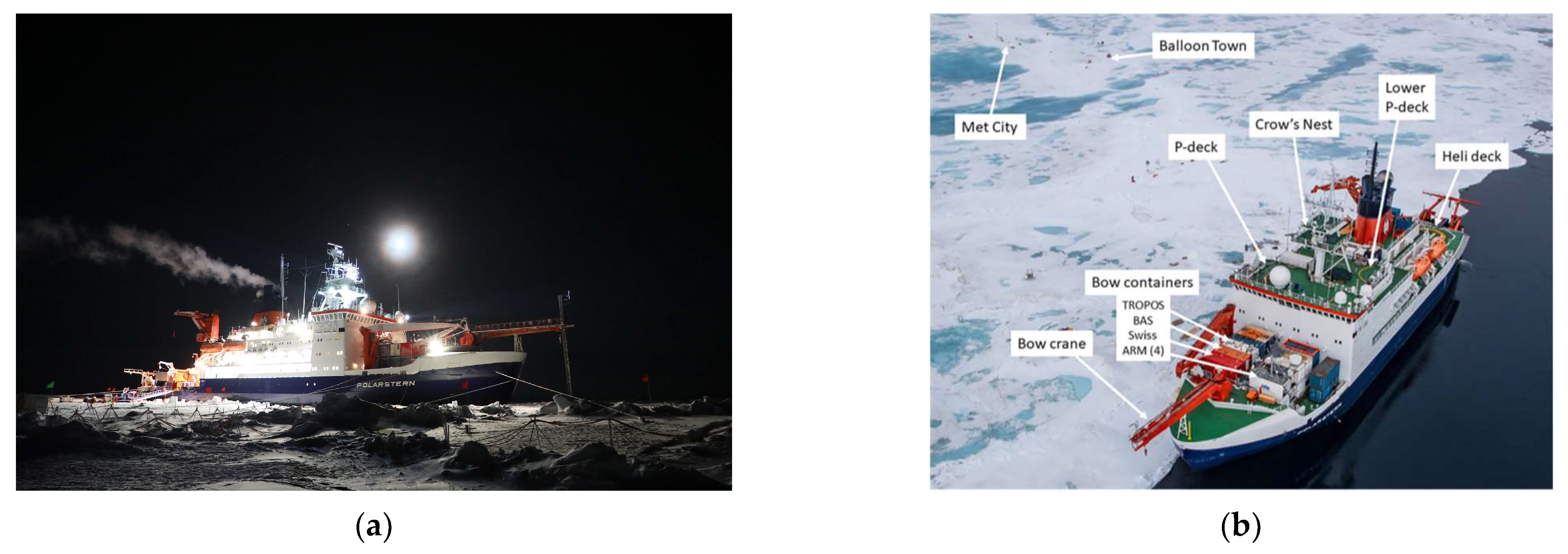
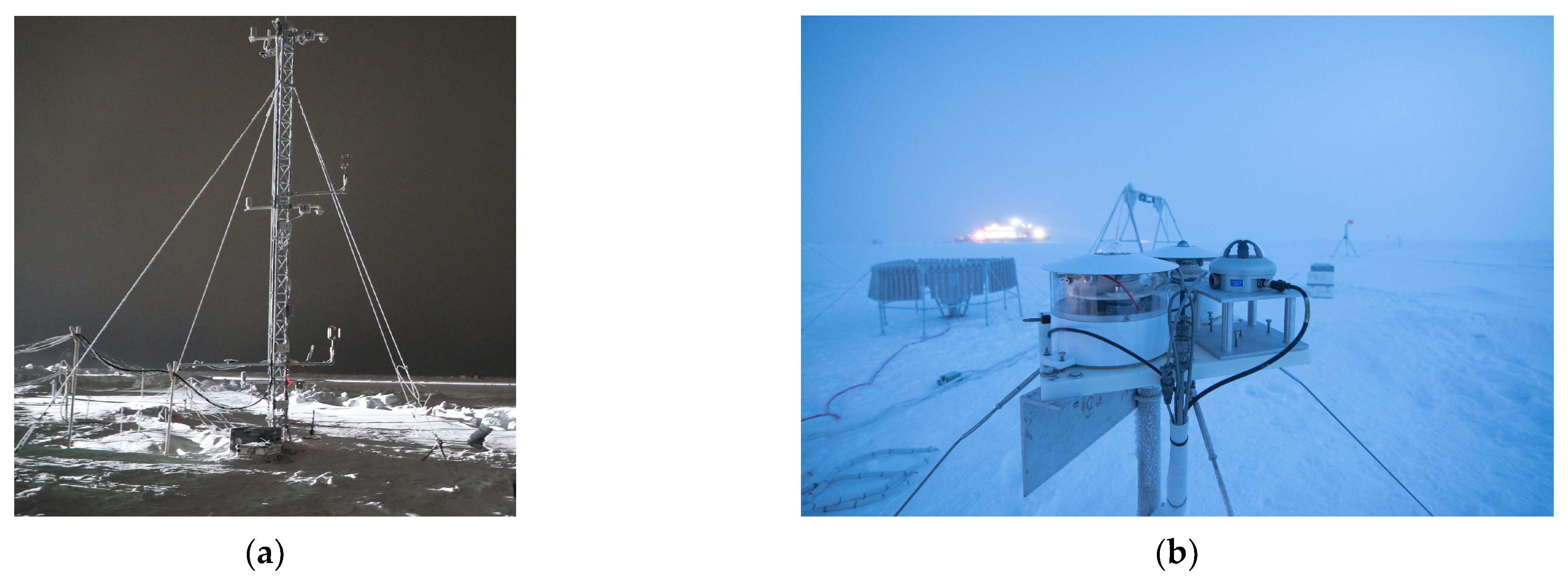



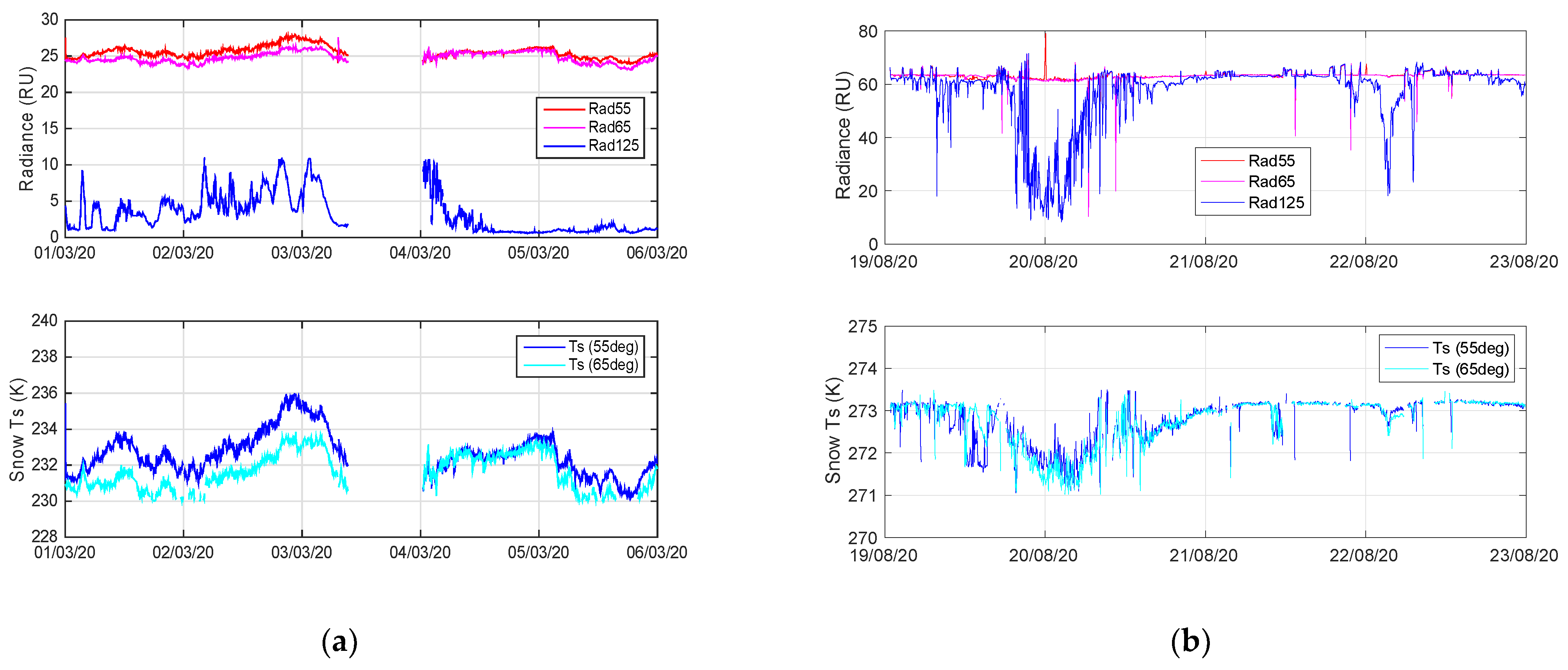
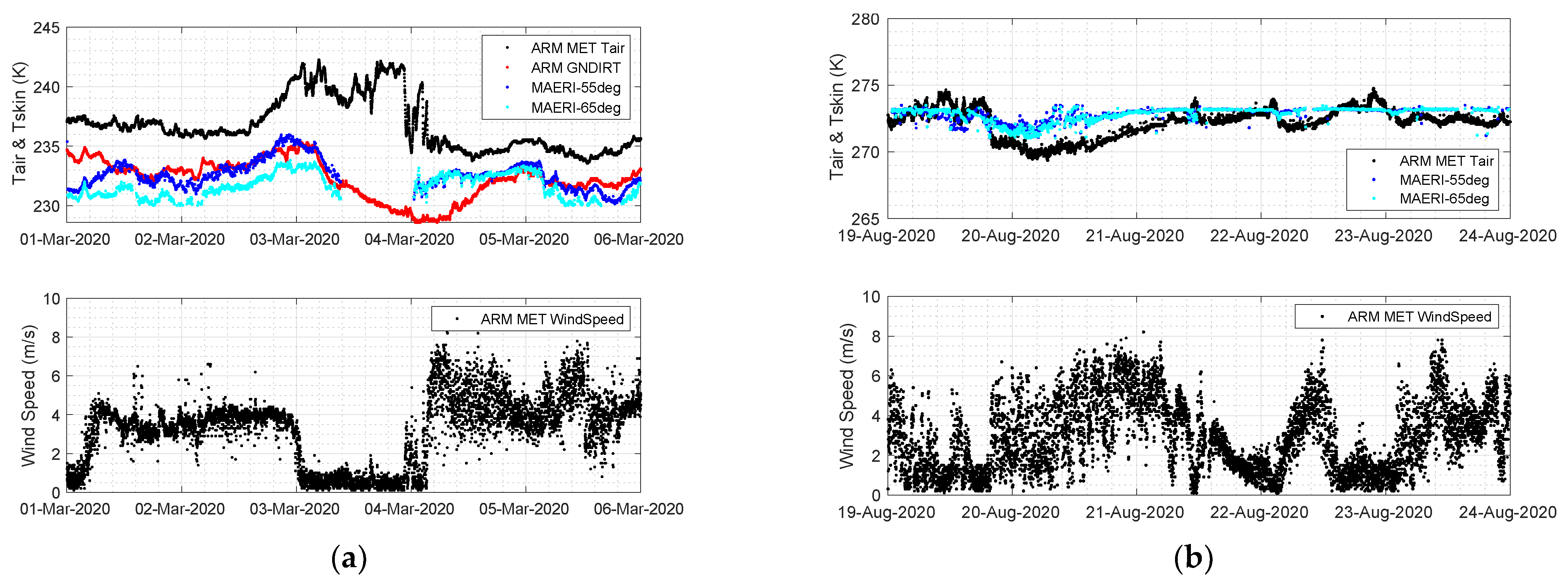
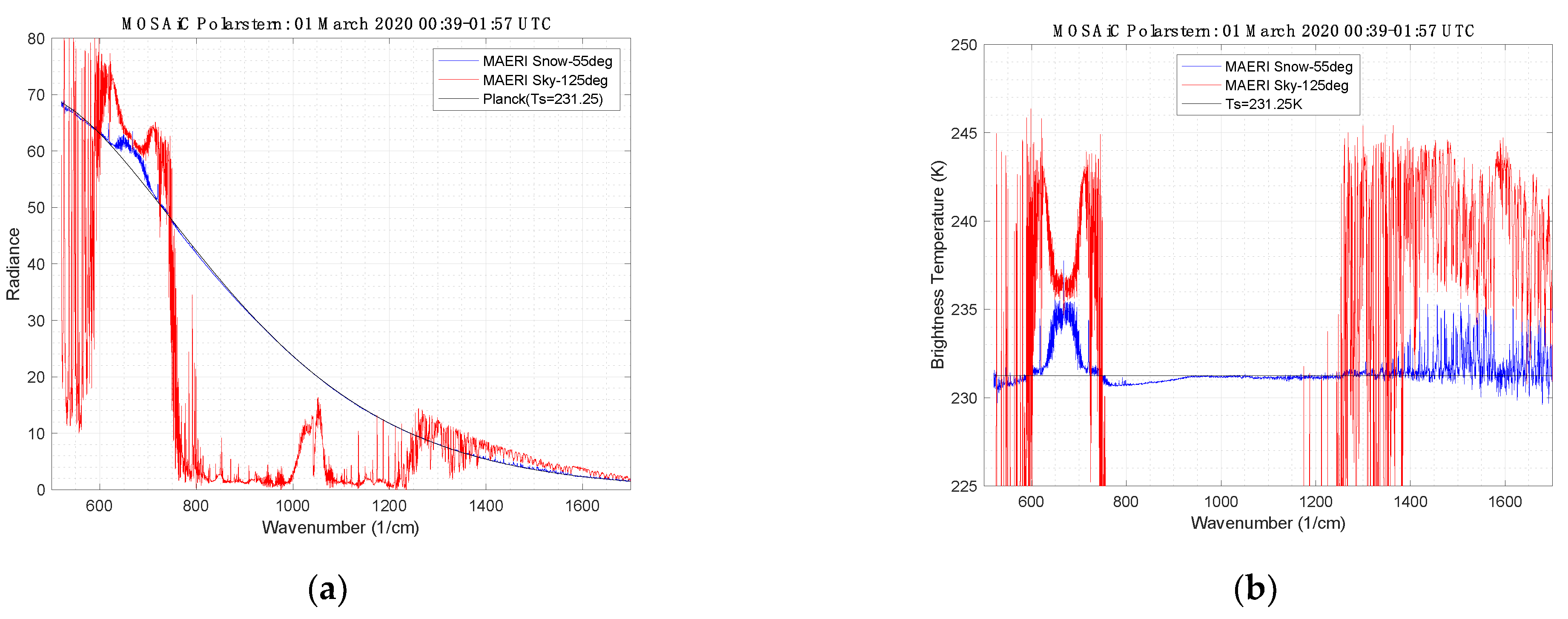
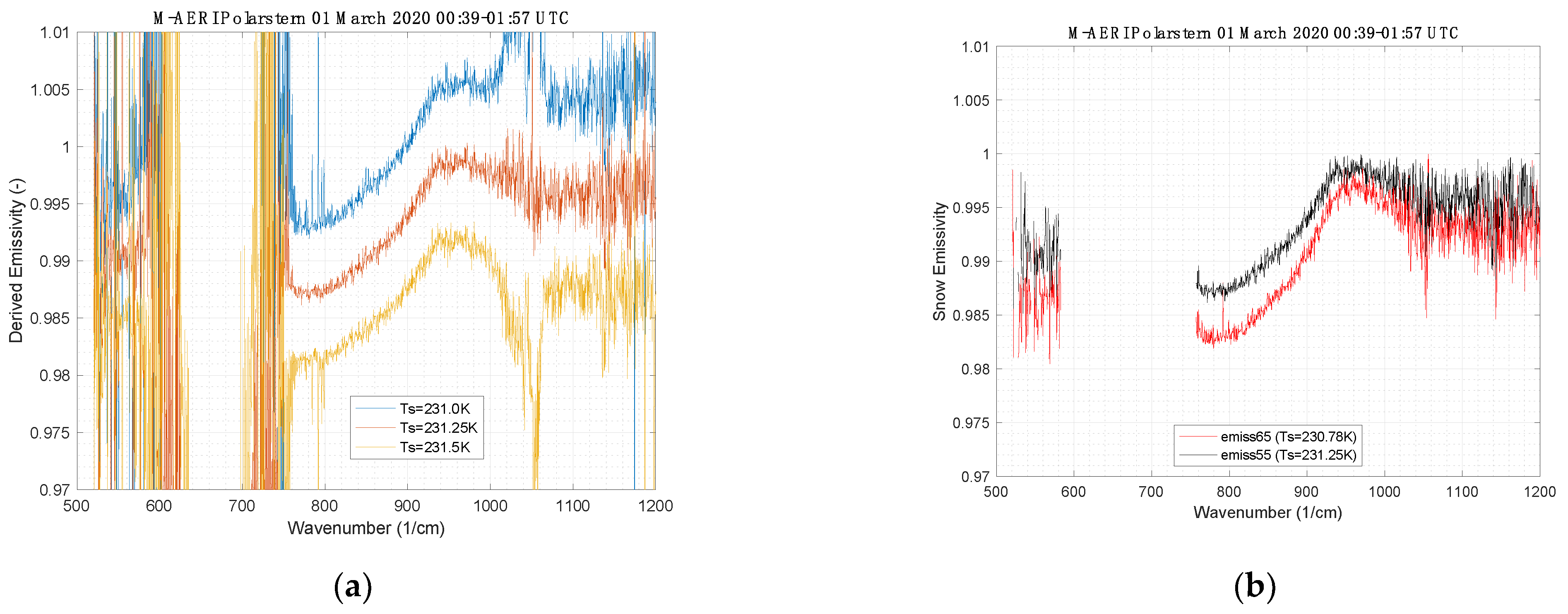
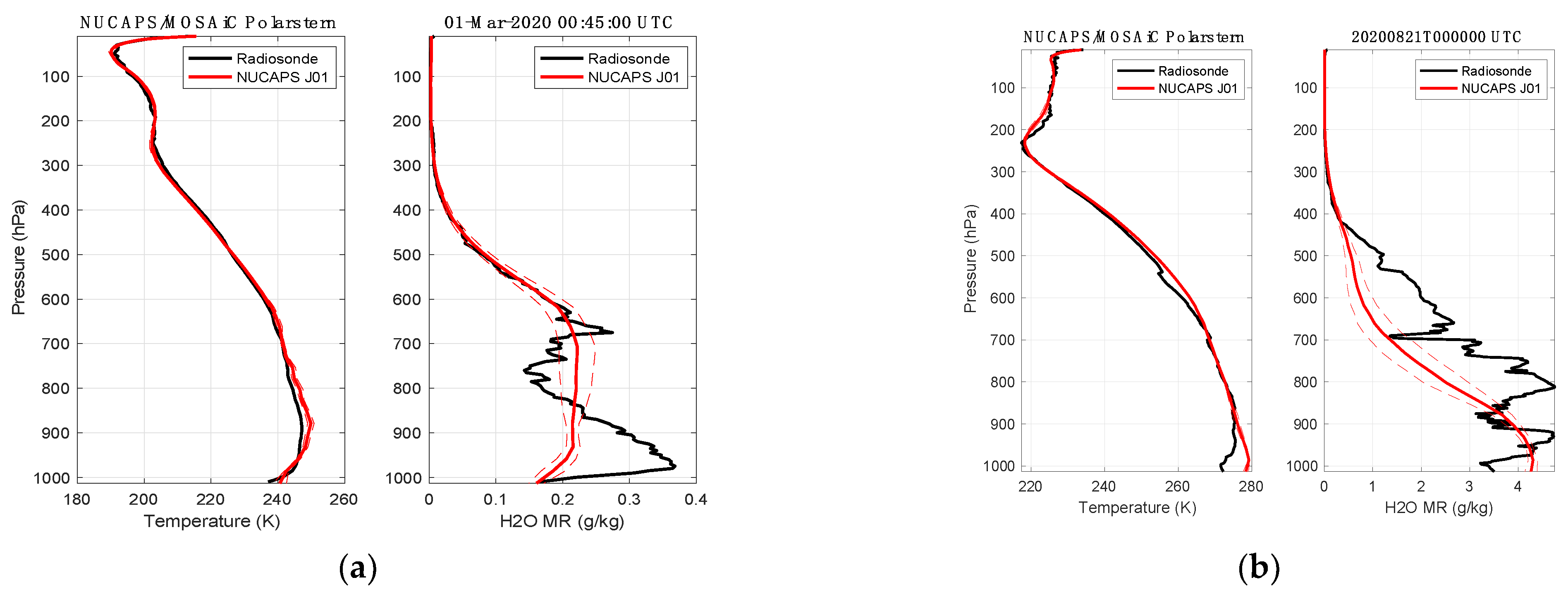
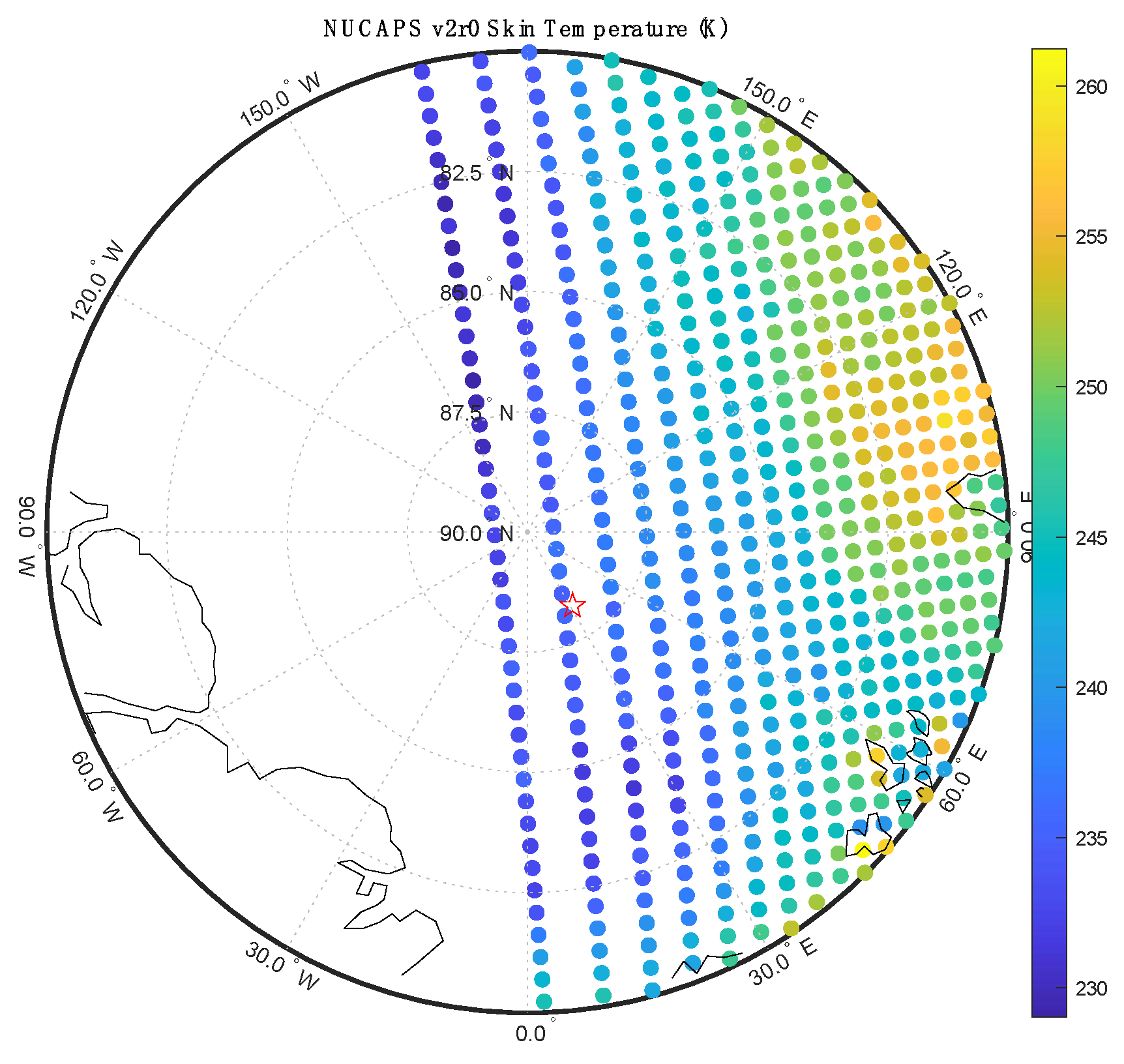

| Date Range | Atmospheric Conditions | Surface Conditions |
|---|---|---|
| 13-January-2020 10-March-2020 | Mostly windy conditions with cloudy skies | First day to March 10th is 100% snow |
| 11-March-2020 19-April-2020 | Snowy and windy conditions through this time period | Starting March 11th, there is a mixture of ice-water-snow |
| 18-July-2020 31-July-2020 | Foggy to clear conditions | Data gap after April, ice transition into open water |
| 21-August-2020 20-Septemter-2020 | Snowy, low visibility | Ice and snow, followed by melt ponds |
| NUCAPS SkinT (K) | ARM IRT (K) | M-AERI 55° | M-AERI 65° |
|---|---|---|---|
| 235.692 ± 1.151 | 234.300 ± 0.084 | 231.3244 ± 0.066 | 230.839 ± 0.109 |
Disclaimer/Publisher’s Note: The statements, opinions and data contained in all publications are solely those of the individual author(s) and contributor(s) and not of MDPI and/or the editor(s). MDPI and/or the editor(s) disclaim responsibility for any injury to people or property resulting from any ideas, methods, instructions or products referred to in the content. |
© 2023 by the authors. Licensee MDPI, Basel, Switzerland. This article is an open access article distributed under the terms and conditions of the Creative Commons Attribution (CC BY) license (https://creativecommons.org/licenses/by/4.0/).
Share and Cite
Nikolla, E.; Knuteson, R.; Gero, J. Hyperspectral Infrared Observations of Arctic Snow, Sea Ice, and Non-Frozen Ocean from the RV Polarstern during the MOSAiC Expedition October 2019 to September 2020. Sensors 2023, 23, 5755. https://doi.org/10.3390/s23125755
Nikolla E, Knuteson R, Gero J. Hyperspectral Infrared Observations of Arctic Snow, Sea Ice, and Non-Frozen Ocean from the RV Polarstern during the MOSAiC Expedition October 2019 to September 2020. Sensors. 2023; 23(12):5755. https://doi.org/10.3390/s23125755
Chicago/Turabian StyleNikolla, Ester, Robert Knuteson, and Jonathan Gero. 2023. "Hyperspectral Infrared Observations of Arctic Snow, Sea Ice, and Non-Frozen Ocean from the RV Polarstern during the MOSAiC Expedition October 2019 to September 2020" Sensors 23, no. 12: 5755. https://doi.org/10.3390/s23125755
APA StyleNikolla, E., Knuteson, R., & Gero, J. (2023). Hyperspectral Infrared Observations of Arctic Snow, Sea Ice, and Non-Frozen Ocean from the RV Polarstern during the MOSAiC Expedition October 2019 to September 2020. Sensors, 23(12), 5755. https://doi.org/10.3390/s23125755








